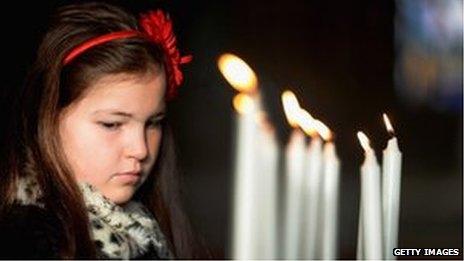Glasgow helicopter crash: memorial service expresses sorrow and hope
- Published

A young girl lights a candle during a service of remembrance for the victims of the Glasgow helicopter crash
On a crisp, sunny December morning, Glasgow Cathedral's congregation arrives for the main Sunday service.
The families walking through the big wooden doors and the elders who welcome them are less chatty than usual, the dress more sombre.
This congregation could not have imagined a week ago that their beautiful medieval church, the ancient seat of Christianity in Glasgow, would host a memorial service for victims of a helicopter crash that would stun their city.
The shock and pain of the previous 36 hours, as the true extent of the incident unfolded, is etched on the faces of many who have come to pay their respects: politicians, members of the emergency services, members of the public.
Among them are the Deputy First Minister Nicola Sturgeon, Justice Secretary Kenny MacAskill, Glasgow Labour MP Anas Sarwar, leader of the city's council Gordon Matheson, and Sir Stephen House, chief constable of Police Scotland.

Deputy First Minister Nicola Sturgeon during a moment of reflection at Glasgow Cathedral
Nursing staff arrive in their uniforms alongside paramedics and ambulance staff who rushed some of the injured from the Clutha bar, where the helicopter came down, to Glasgow Royal Infirmary.
The Royal Infirmary overlooks the cathedral, and before entering the church many look up at the hospital's imposing Edwardian facade.
Inside the cathedral the pews of the magnificent 13th century nave are full as the Rev Dr Laurence Whitley stands to deliver a service he hopes will bring consolation and solace to the city.
He seeks to "give expression to the feeling that Glasgow does not just remember its bereaved and injured in its hour of need - it keeps remembering and keeps pulling together." Glaswegians respond with their heart before anything else, he says.
The music used in the service also gives expression to this feeling of sorrow, remembrance and hope. The cathedral choir sing Elgar's soaring Enigma Variation IX - known as Nimrod - from above, while the choice of the hymn Abide With Me, sung by the full congregation, is particularly poignant.
Both the very young and the very old are given their chance to reflect and take part.
Eight candles, one for each person known to have died in the crash, are lit by children, all members of the cathedral's Sunday school.
Afterwards, Isa Revie, aged 90, who lives in the Drygate district in the east end, just a few hundred yards from the cathedral, says she doesn't normally manage to attend church but was brought to the service by her niece because she "wanted to show solidarity with everyone involved. I wanted them to know I was thinking of them."
Community spirit
After the service, as the congregation disperses into the bright sunlight of Cathedral Square, there is a feeling of relief. People gather to share their thoughts and discuss how Glasgow and its citizens will cope with the difficult days and weeks to come.
Margaret Lance, an elder at the cathedral who lives in the Gorbals, came to Glasgow nine years ago from Cameroon in west Africa. She says the city's community spirit will play a vital role.
"Glaswegians are such lovely people," she says. "I will never forget how friendly and hospitable people were when I first arrived here. Now Glasgow feels like home. People are grieving, but they will comfort each other."
- Published1 December 2013
- Published12 December 2013
- Published30 November 2013
- Published30 November 2013
- Published1 December 2013
- Published30 November 2013
- Published30 November 2013
- Published30 November 2013
- Published30 November 2013
- Published30 November 2013
- Published1 December 2013
- Published30 November 2013